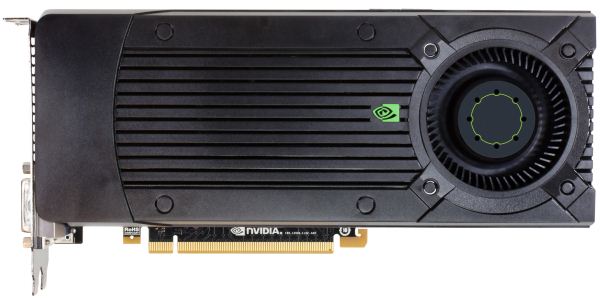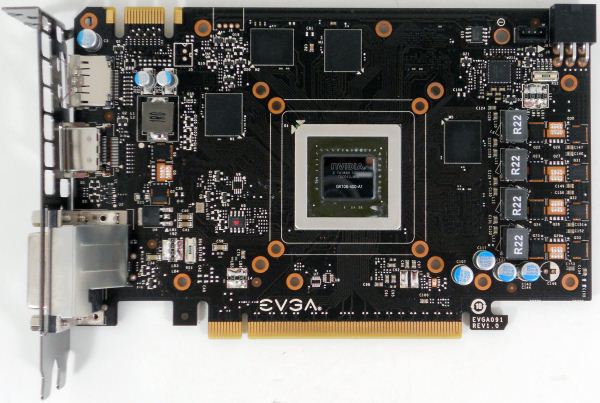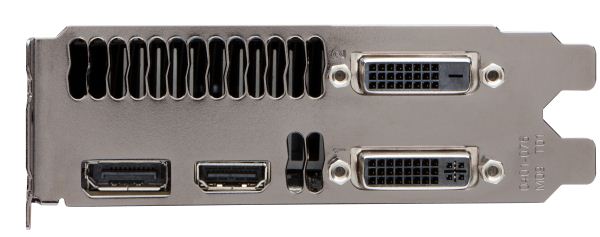The NVIDIA GeForce GTX 660 Review: GK106 Fills Out The Kepler Family
by Ryan Smith on September 13, 2012 9:00 AM ESTMeet The GeForce GTX 660
For virtual launches it’s often difficult for us to acquire reference clocked cards since NVIDIA doesn’t directly sample the press with reference cards, and today’s launch of the GeForce GTX 660 launch is one of those times. The problem stems from the fact that NVIDIA’s partners are hesitant to offer reference clocked cards to the press since they don’t want to lose to factory overclocked cards in benchmarks, which is an odd (but reasonable) concern.
For today’s launch we were able to get a reference clocked card, but in order to do so we had to agree not to show the card or name the partner who supplied the card. As it turns out this isn’t a big deal since the card we received is for all practical purposes identical to NVIDIA’s reference GTX 660, which NVIDIA has supplied pictures of. So let’s take a look at the “reference” GTX 660.
The reference GTX 660 is in many ways identical to the GTX 670, which comes as no great surprise given the similar size of their PCBs, which in turn allows NVIDIA to reuse the same cooler with little modification. Like the GTX 670, the reference GTX 660 is 9.5” long, with the PCB itself composing just 6.75” of that length while the blower and its housing composes the rest. The size of retail cards will vary between these two lengths as partners like EVGA will be implementing their own blowers similar to NVIDIA’s, while other partners like Zotac will be using open air coolers not much larger than the reference PCB itself.
Breaking open one of our factory overclocked GTX 660 (specifically, our EVGA 660 SC using the NV reference PCB), we can see that while the GTX 670 and GTX 660 are superficially similar on the outside, the PCB itself is quite different. The biggest change here is that while the 670 PCB made the unusual move of putting the VRM circuitry towards the front of the card, the GTX 660 PCB once more puts it on the far side. With the GTX 670 this was a design choice to get the GTX 670 PCB down to 6.75”, whereas with the GTX 660 it requires so little VRM circuitry in the first place that it’s no longer necessary to put that circuitry at the front of the card to find the necessary space.
Looking at the GK106 GPU itself, we can see that not only is the GPU smaller than GK104, but the entire GPU package itself has been reduced in size. Meanwhile, not that it has any functional difference, but GK106 is a bit more rectangular than GK104.
Moving on to the GTX 660’s RAM, we find something quite interesting. Up until now NVIDIA and their partners have regularly used Hynix 6GHz GDDR5 memory modules, with that specific RAM showing up on every GTX 680, GTX 670, and GTX 660 Ti we’ve tested. The GTX 660 meanwhile is the very first card we’ve seen that’s equipped with Samsung’s 6GHz GDDR5 memory modules, marking the first time we’ve seen non-Hynix memory on a GeForce GTX 600 card. Truth be told, though it has no technical implications we’ve seen so many Hynix equipped cards from both AMD and NVIDIA that it’s refreshing to see that there is in fact more than one GDDR5 supplier in the marketplace.
For the 2GB GTX 660, NVIDIA has outfit the card with 8 2Gb memory modules, 4 on the front and 4 on the rear. Oddly enough there aren’t any vacant RAM pads on the 2GB reference PCB, so it’s not entirely clear what partners are doing for their 3GB cards; presumably there’s a second reference PCB specifically built to house the 12 memory modules needed for 3GB cards.
Elsewhere we can find the GTX 660’s sole PCIe power socket on the rear of the card, responsible for supplying the other 75W the card needs. As for the front of the card, here we can find the card’s one SLI connector, which like previous generation mainstream video cards supports up to 2-way SLI.
Finally, looking at display connectivity we once more see the return of NVIDIA’s standard GTX 600 series display configuration. The reference GTX 660 is equipped with 1 DL-DVI-D port, 1 DL-DVI-I port, 1 full size HDMI 1.4 port, and 1 full size DisplayPort 1.2. Like GK104 and GK107, GK106 can drive up to 4 displays, meaning all 4 ports can be put into use simultaneously.














147 Comments
View All Comments
chrnochime - Thursday, September 13, 2012 - link
You mean that they spun the results in NV's favor when the 670 came out, and then again in AMD's favor when comparing OC results from 7950 against 660TI OC and 670 OC?chizow - Thursday, September 13, 2012 - link
Is AMD going to issue rebates for the 7870? $150 price drop in 4 months is pretty sad beans for all the AMD early adopters.RussianSensation - Thursday, September 13, 2012 - link
No, because if you want the latest tech on latest 28nm, you understand you are paying a premium for it. If not, you sit out for 6-7 months and wait for more price drops. This is how it always worked. I am sure early AMD adopters don't care since their cards already paid for most of their cost with bitcoin mining on the side and they have enjoyed a cool and efficient card for 7 months. How are your 680s doing that you dropped $1k on?Care to remind everyone that GTX280 launched at $649 on June 16, 2008, dropped $150 1 month immediately when 4870 launched and then 9.5 months later AMD delivered a $269 HD4890 that offered similar performance.
I guess in that generation the early adopter lost $380 by going with the 280 in just 9.5 months but you failed to mention that's how it works in the GPU industry.
chizow - Thursday, September 13, 2012 - link
Except we already knew the 7870 wasn't worth the asking price when it was released, so the natural response would've been to wait by those who already knew price drops were imminent on grossly inflated 28nm parts.And I guess you already forgot, Nvidia did right by its early adopting customers by issuing $100-$150 rebates to those who bought a GTX 260 or 280 before the price drops, which is why I asked. Same reason I asked if AMD was going to do the same if and when Nvidia adjusted the pricing landscape with Kepler to force cuts across the board for AMD's ridiculous pricing structure. So again, where are AMD's rebates given every 28nm part they released is worth roughly 30-40% less than original MSRP? That's more than even your referenced drops on the GTX 260/280.
4890 was nothing special, Nvidia released an equivalent GTX 275 for similar price and those prices were due largely to price wars in the midst of a massive global recession.
As for my $1K GTX 680s, they don't exist because I wouldn't pay that much for such a small increase in generational performance on a midrange ASIC, I paid $660 for 2x GTX 670 on 680 PCBs instead which is probably still a bit more than I think they are worth, but I figure after the 2x Borderlands promos they are much closer to the $300 price point a 2nd tier GK104 SKU should have been sold at anyways. :D
rarson - Friday, September 14, 2012 - link
"Except we already knew the 7870 wasn't worth the asking price when it was released"So the people who "knew" this weren't buying it anyway, and hence do not need a rebate. You really should read what you write before posting your comment.
Here's how technology works, dude: new technology is expensive. As time goes on, it becomes cheaper as more people start adopting it. The 7870 really was worth the price when it came out (no shit, it really was). You can figure this out by seeing that people actually went and bought them. Supply was constrained and the process was very expensive (more so than previous process shrinks) so even just getting the wafers allocated was tougher than before. On top of that, AMD had to adjust their pricing to deal with the constrained supply. Price it too low, and whatever stock that you have sells out too quickly and you sit for months with no stock on the shelf, selling nothing (just ask Nvidia).
I know, I know, you can't grasp basic economics. I'm wasting my breath. Maybe once you move out of the basement you'll figure out how the real world works.
chizow - Friday, September 14, 2012 - link
Yeah it was a rhetorical question, I know AMD isn't issuing rebates, they don't have the money to return they'd just be borrowing more from Abu Dhabi to cut that check that might very well bounce.As for how technology works, you once again demonstrate how little you know about the industry. Prices drop, like the GTX 580/570 and 6970/6950 that held their prices for a good full 20 months before the launch of 28nm parts? And even after the launch of 28nm, they still held their prices because there was no incentive or need to drop in price based on relative price and performance?
You have no idea what you're talking about, stop typing. Parts lose their value and drop in price when a new part forces that change. Usually this happens when a new generation of product or a new process/fabrication node forces the change by introducing a dramatic increase in price:performance. In this case, the prices drops are being forced by products that are the *SAME* process and relative generation (from Nvidia).
What this *SHOULD* tell you is that the 28nm offerings from AMD were grossly overpriced and offered FAR less improvement for the asking price, but these simple concepts obviously escape you.
Galidou - Saturday, September 15, 2012 - link
660$ for 2 gtx 670 on 680 pcbs, you got engineer samples? I've been looking on ebay for USED 670 and the best price one ended was 355$ with shipping and that was without the borderlands 2 coupon. I've seen some reference cards going down to 344$ before taxes and after 20$ mail in rebate(around 380$ shipped) but they were FAR from 680 PCBs.I'd really like to see those 670's at 330$ with 680 PCB's, would really like.....
One comment about the rebate on the gtx 280, it's quite different from now. The 549$ radeon 7970 lost to a 499$ gtx 680 3 months after it's launch.
The 650$ gtx 280 was on average 10% better and sometimes 10% worse than the 300$ radeon 4870 one month after it's launch...
chizow - Saturday, September 15, 2012 - link
Hi Galidou, you're not here to defend AMD's launch prices again too are you?670 on 680 PCBs are quite commonplace, maybe you've heard of the EVGA FTW versions? Galaxy has a similar one with their GC parts, no engineering samples needed:
http://forums.anandtech.com/showthread.php?t=22660...
http://www.newegg.com/Product/Product.aspx?Item=N8...
Please feel free to check the reviews on Newegg link, you will see I'm a verified owner. ;)
As for the GTX 280, once again more revisionist history from the usual suspects. GTX 280 was closer to 15-20% faster especially at high resolutions with AA due to the 1GB VRAM compared to the 4870's 512MB. The gap widens even further if you look at later reviews.
http://www.computerbase.de/artikel/grafikkarten/20...
Only after the 1GB 4870 and 4890 releases months later did this change so the price difference even after the $150 price cut to $500 was still justifiable. I still have a GTX 280 as a backup card and it still runs modern games great, a 512MB 4870 would barely be able to handle the default frame buffer....
Secondly, GTX 280's asking price was reasonable compared to last-gen parts, unlike AMD's 28nm parts, as it offered 2x the performance of the 8800/9800GTX, more performance than the 9800GX2 or 3870X2, and almost tripled the performance of AMD's fastest single GPU, the 3870. What Nvidia did not account for was both AMD's return to competitiveness with the RV770 *AND* their massive undercut on pricing simultaneously.
Lastly, of course, is Nvidia actually did right by their customers by issuing those rebates, which is just good business to ensure they took care of their most enthusiastic customers. Certainly more than we can say for AMD though. AMD may have made some short-term profit, but at what cost? They certainly have more than a few fans who are going to be outraged by the massive cuts so soon after launch.
Galidou - Saturday, September 15, 2012 - link
I just removed the 4870 512mb I had and it still runs perfectly but my wife used it on a 1680*1050 monitor. The 280 took advantage at 2560*1600, but you can imagine it was mainly for benchmark purposes. Not a lot of people do use this resolution NOW so imagine 4 years ago... let's say >0,05% back in 2008(most of them being artists and not gamers), considering the cost of one of those monitors... yep you guessed it, about the price of 2 gtx 280 at launch, for ONE monitor.... The price of my whole computer with the 4870 back in 2008...''Secondly, GTX 280's asking price was reasonable compared to last-gen parts, unlike AMD's 28nm parts, as it offered 2x the performance of the 8800/9800GTX''
When AMD fanboys said the 7970 was priced rightly compared to last gen parts(which it was, there was no bargain for sure but it was 40% higher price for 70% more perf) Nvidia fanboys said: You gotta be freaking kidding me, are you blind, ffs remove your red glasses and wake up''.
''Hi Galidou, you're not here to defend AMD's launch prices again too are you?''
Not necessarily but it seems you are here to attack them again. A 550$ card loses in 65% of the games to a 500$ card 3 months after it's launch(radeon 7970 vs gtx 680)....a 650$ card is 10% faster than a 300$ card in 60% of the games one month after it's launch(gtx 280 vs 4870). My reflections above seemed logical to me, I guess life is a question of perception.
Galidou - Saturday, September 15, 2012 - link
I think there's one thing we should say about pricing mistakes and rebate. A gamer buying an i7 980x 1 week prior to the sandy bridge launch, and I know it happened... poor them...Nice link on the German website, you must of looked a lot of websites to find a 20% advantage on average for a gtx 280 because tom hardware, techpowerup and anandtech shows it average 10% faster but nice finding you got there. If only I could read German. And we both know the websites I named above are certainly more highly regarded than computerbase.de..........
And good job, because I'm really looking forward to change the gtx 660 ti I got for my wife for a gtx 670 but the best I could get to is either 355$ USED(an auction, not a buy it now) on ebay or 344$ before taxes and after mail in rebate(hate those I'm usually not even using them because they use your information to harass your life). But I guess it's possible to find them at 330$ after mail in rebate and before taxes but in the end it's closer to the 400$ mark than the 300$ mark.